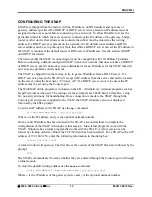
SNAP2411
SNAP2411D
Figure 6 shows the SNAP2411D with a closeup of the Status Indicators.
Figure 6. SNAP2411D
The antenna connector is a reverse polarity TNC type connector. An antenna may be connected
directly to this connector. Alternatively, an antenna may be located away from the SNAP using
RF cable to connect the SNAP to the antenna. Cirronet does not recommend using RF cables
longer than 5 feet. If more distance is required between the SNAP and the antenna Cirronet
recommends using the SNAP2411DX. If the SNAP2411DX is not used, high-quality, low-loss
RF feed line must be used.
The 10/100BaseT Ethernet connector is the standard RJ-45 connector. The connector is wired to
be able to connect directly to an Ethernet hub using a cross-over cable. If it is desired to connect
the SNAP directly to a PC without a hub, the SNAP must be connected with a straight through
cable. (Both cables are provided.)
The synchronizing signals are provided for special applications where multiple master SNAPs
are employed. The synchronizing signals are RS-485 levels and may be connected using an RJ-
11 connector. SNAPs will automatically determine which SNAP will generate the sync signal.
See the section
Synchronization
for details. In most instances the synchronizing signals are not
required and may be left unconnected.
The power connector is a 2-pin DIN type connector. The provided AC adapter provides a 12 volt
power level to the SNAP. The SNAP can accept DC voltages ranging between 9VDC and
26VDC if alternative power supplies are to be used.
The Configuration Port is an RS-232 serial port that may be used to configure the SNAP. This is
useful when the default IP address of the SNAP cannot be used with the existing network
©
2000- 2004 Cirronet
™
Inc
8
M-2411-0012 Rev -















































